Top 10 Beans and Legumes Highest in Protein
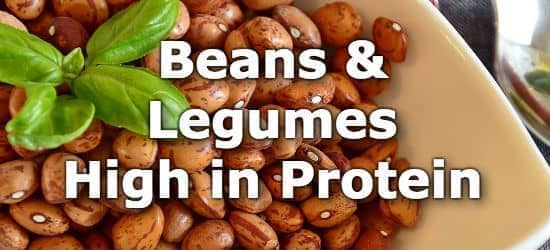
Beans and legumes are an inexpensive and heart-healthy group of foods, which are popular all around the world. In addition to being high in protein, beans and legumes are also good sources of fiber, iron, and potassium.
The current daily value (DV) for protein is 50 grams per day. (1) This is considered to be a healthy target amount for most people. Most beans provide between 29% and 36% of the DV for protein per cup cooked. Boiled soybeans (or edamame) provide a whopping 63% of the DV.
Beans and legumes that are particularly high in protein include soybeans, lentils, white beans, cranberry beans, split peas, pinto beans, kidney beans, black beans, navy beans, and limas. The list below is ranked by the most protein per cup cooked. This list includes only whole beans and legumes, not products made from these foods. For bean products like tofu and hummus see the extended list of beans and bean products high in protein.
List of High Protein Beans
-
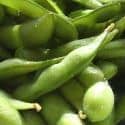 1. Boiled Soybeans (Edamame) + Add
1. Boiled Soybeans (Edamame) + Add
Protein
per CupProtein
per 100gProtein
per 200 Calories31.3g
(63% DV)18.2g
(36% DV)21.2g
(42% DV) -
 2. Lentils + Add
2. Lentils + Add
Protein
per CupProtein
per 100gProtein
per 200 Calories17.9g
(36% DV)9g
(18% DV)15.6g
(31% DV) -
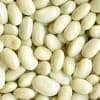 3. Large White Beans + Add
3. Large White Beans + Add
Protein
per CupProtein
per 100gProtein
per 200 Calories17.4g
(35% DV)9.7g
(19% DV)14g
(28% DV) -
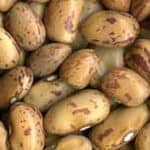 4. Cranberry (Borlotti) Beans + Add
4. Cranberry (Borlotti) Beans + Add
Protein
per CupProtein
per 100gProtein
per 200 Calories16.5g
(33% DV)9.3g
(19% DV)13.7g
(27% DV) -
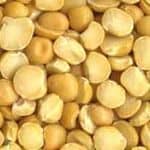 5. Split Peas + Add
5. Split Peas + Add
Protein
per CupProtein
per 100gProtein
per 200 Calories16.3g
(33% DV)8.3g
(17% DV)14.1g
(28% DV) -
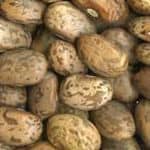 6. Pinto Beans + Add
6. Pinto Beans + Add
Protein
per CupProtein
per 100gProtein
per 200 Calories15.4g
(31% DV)9g
(18% DV)12.6g
(25% DV) -
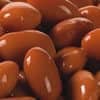 7. Kidney Beans + Add
7. Kidney Beans + Add
Protein
per CupProtein
per 100gProtein
per 200 Calories15.3g
(31% DV)8.7g
(17% DV)13.7g
(27% DV) -
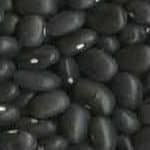 8. Black Beans (Frijoles Negros) + Add
8. Black Beans (Frijoles Negros) + Add
Protein
per CupProtein
per 100gProtein
per 200 Calories15.2g
(30% DV)8.9g
(18% DV)13.4g
(27% DV) -
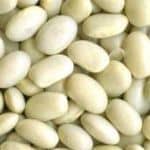 9. Navy (Haricot) Beans + Add
9. Navy (Haricot) Beans + Add
Protein
per CupProtein
per 100gProtein
per 200 Calories15g
(30% DV)8.2g
(16% DV)11.8g
(24% DV) -
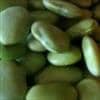 10. Lima (Butter) Beans + Add
10. Lima (Butter) Beans + Add
Protein
per CupProtein
per 100gProtein
per 200 Calories14.7g
(29% DV)7.8g
(16% DV)13.6g
(27% DV)
Printable One Page Sheet
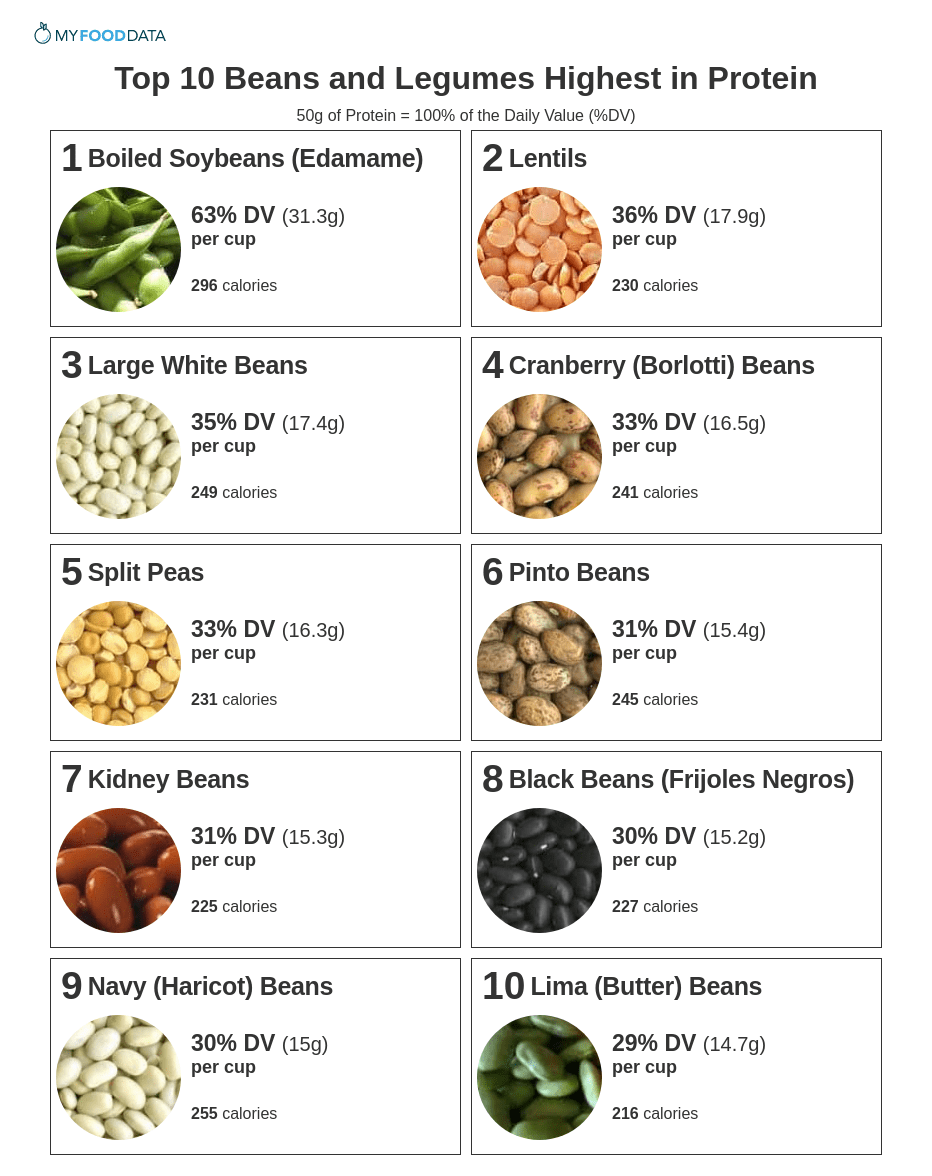
More Bean and Bean Products High in Protein
| Food | Serving | Protein |
|---|---|---|
| 1. Firm Tofu + | per cup | 87% DV (43.5g) |
| 2. Tempeh + | per cup | 67% DV (33.7g) |
| 3. Lupin Beans + | 1 cup | 52% DV (25.8g) |
| 4. Adzuki Beans + | per cup | 35% DV (17.3g) |
| 5. Great Northern Beans + | per cup | 29% DV (14.7g) |
| 6. Chickpeas (Garbanzo Beans) + | per cup | 29% DV (14.5g) |
| 7. Mung Beans + | per cup | 28% DV (14.2g) |
| 8. Unsweetened Soymilk + | per 16oz glass | 28% DV (14g) |
| 9. Mungo Beans + | 1 cup | 27% DV (13.6g) |
| 10. Broad Beans (Fava) + | per cup | 26% DV (12.9g) |
| 11. Peanut Butter + | per 2 tblsp | 14% DV (7.1g) |
| 12. Peanuts (Dry Roasted) + | per oz | 14% DV (6.9g) |
| 13. Falafel + | 1 falafel | 5% DV (2.3g) |
| 14. Miso Paste + | 1 tblsp | 4% DV (2.2g) |
| 15. Hummus + | 1 tblsp | 2% DV (1.2g) |
From the Nutrient Ranking Tool
Use the ranking tool links below to select foods and create your own food list to share or print.
- Foods High in Protein
- Foods Low in Protein
- Vegetables High in Protein
- Fruits High in Protein
- Vegetarian Foods High in Protein
- Nuts High in Protein
- Grains High in Protein
- Beans High in Protein
- Dairy High in Protein
- Breakfast Cereals High in Protein
- Fast Foods High in Protein
View more nutrients with the nutrient ranking tool, or see ratios with the nutrient ratio tool.
Related
Data Sources and References
Simplify Nutrition Tracking with MyFoodData!
Speedy Tools and Detailed Data FREEEasily analyze your meals to find the best foods for your goals.
✅ Use our recipe nutrition calculator and nutrition comparison tool.
✅ Access expert nutrition data tools and in-depth articles.
✅ Log foods and organize your recipes with a free account.


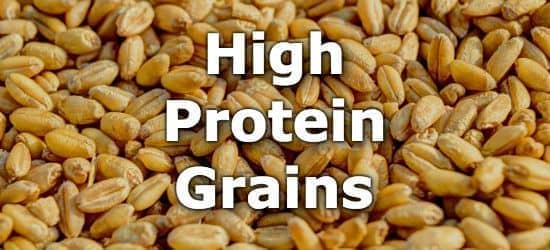 Next ➞
Next ➞
